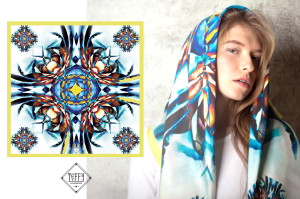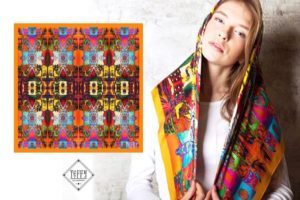 After graduating at the University in 2010 I worked as a designer of men’s clothes at O’stin, a big Russian company. That was a very important experience for me, as I learnt how the whole process of mass market collection works. I was so proud to see men in my clothes in the city. Then I decided to study fashion management in Europe, because at that time Russian Universities couldn’t offer something valuable in this areas. So I won a scholarship in Domus Academy in Milan and I spent 2 very challenging years there. Thanks to Domus I had a great opportunity to work on real projects with important brands such as Versace, Red Valentino, Vogue Italia and Excelsior. There I found how real professionals work in Europe, and under their mentoring I did my final project. After graduating I found an internship in Milan where I was working with bloggers, social media and PR. At that time I was also working as a freelance designer for some Asiatic labels, that gave me an idea about that target and preferences of different people.
After graduating at the University in 2010 I worked as a designer of men’s clothes at O’stin, a big Russian company. That was a very important experience for me, as I learnt how the whole process of mass market collection works. I was so proud to see men in my clothes in the city. Then I decided to study fashion management in Europe, because at that time Russian Universities couldn’t offer something valuable in this areas. So I won a scholarship in Domus Academy in Milan and I spent 2 very challenging years there. Thanks to Domus I had a great opportunity to work on real projects with important brands such as Versace, Red Valentino, Vogue Italia and Excelsior. There I found how real professionals work in Europe, and under their mentoring I did my final project. After graduating I found an internship in Milan where I was working with bloggers, social media and PR. At that time I was also working as a freelance designer for some Asiatic labels, that gave me an idea about that target and preferences of different people.
And now I’m back to Moscow to organize my own label. These days I’m working on my personal project Teffy, a limited collection of designer scarves from natural silk. I create the whole chain: from the idea, to the sketches to the final customer.
Where do you get inspired?


 Usually my day starts watching the list of my favorite blogs and Facebook. There I find some interesting ideas which inspire me to do something new. I also enjoy cultural life a lot, I like museums and theaters and so on. I really love drawing (sometimes I work as a fashion illustrator) and this is also a huge source of inspiration for me.
Usually my day starts watching the list of my favorite blogs and Facebook. There I find some interesting ideas which inspire me to do something new. I also enjoy cultural life a lot, I like museums and theaters and so on. I really love drawing (sometimes I work as a fashion illustrator) and this is also a huge source of inspiration for me.
Considering your background in Italy, which is, in your opinion, the idea of the Made in Italy in Russia?
For Russian people the Made in Italy is synonym of quality. But at the same time is means fashionable and high class. Customers now are more used to thinking before buying, which makes them more careful when they look for quality. But, on the other hand, some people just want to show their status with branded and expensive clothes.
Is the Russian taste closer to the European taste compared to the past?
Russian people changed a lot, they started to travel abroad and see how people look in other countries. In some ways Russians are getting closer to Europeans, people started to think about their own style instead of just putting on some labels. Now a lot of young people in big cities want to look simple but stylish. They prefer some limited collections to famous brands and while the image of their inhabitants was changing, in some big cities such as Moscow or S. Petersburg a lot of new big and small concept stores were opened. ut the situation in small cities and towns is completely different. People there can’t afford expensive and quality brands, they look for something more affordable, and this sometimes means a lack of design and quality. And this kind of product also comes from Italy. Speaking with a manager that runs a logistic business between Russia and Italy I came to know that every week they transfer tonnes of clothes from Italy (Center Gross Bologna) which does not correspond at all to our idea of Italian quality.
What do you think is the first thing that a foreign company has to do when approaching the Russian market?
For sure the most important point is target. The Russian customer is different from a European customer. We have another mentality, a different way of thinking. So the first task is to understand your customer. A good starting point could be hiring a person who knows the market and can predict or overcome some difficulties typical of this market.
Another point is climate. It is so different in many regions of our big country and sometimes foreign brands aren’t able to propose clothes suitable for these conditions. The good news is that we have a huge, almost empty, market. Without some global brands like Zara, Benetton, Top Shop and some Russian brands (which I can count on the fingers of my hand) I can’t even imagine what young people in Russia would wear.




